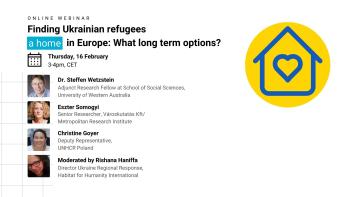
Housing of Ukrainian Refugees in Europe
Options for Long-Term Solutions
This is an excerpt of the research report by the Metropolitan Research Institute on long-term housing of Ukrainian refugees in Europe, commissioned by Habitat for Humanity International, and published in February 2023. Please scroll down to access the full report.
After a short post-COVID-19 recovery year, on February 24th 2022, Russia invaded Ukraine, devastating cities, destroying critical infrastructure, and forcing millions of people to leave their homes. According to data provided by host governments to UNHCR, between February 24th and December 6th, 2022, more than 7.8 million individuals fleeing Ukraine were registered across Europe.
The social situation of refugees is very diverse, ranging from Roma families in extreme poverty to upper-middle-class families with very different housing expectations and the ability to bear the related costs and integrate into local job markets.
Russia’s invasion of Ukraine has forced more than 13 million people from their homes. Habitat for Humanity organized a webinar launching a report from the Metropolitan Research Institute on the long-term housing of Ukrainian refugees in Europe.
To provide immediate and effective protection for such a large displaced population, the Council of the European Union activated the 2001 Temporary Protection Directive. As the primary responsibility of refugee protection lies with states, the Directive specifies a number of duties of governments in relation to the reception and residence of beneficiaries of temporary protection. As a result, Ukrainians are treated more favorably than recognized refugees and beneficiaries of subsidiary protection who arrive from other third countries.
The refugee crisis in Ukraine represents an unprecedented burden for Europe: 7.8 million people face incredible challenges finding housing, health, education and social services that correspond to their social composition (gender, age, education, etc.). Moreover, the four Central-Eastern European countries were not primary destination or transit countries for asylum seekers before the war, thus, were not prepared to provide for such a large number of refugees. Besides establishing reception centers and collective sites, the first step in providing humanitarian assistance was to use existing housing stock as temporary solutions and service capacity (such as emergency education and social care), partly on a voluntary (solidarity) basis. This was followed by their scaling up using funding from various public and private resources with the participation of various NGOs. Setting up a reception and provision system for such a large number of refugees in a very short time led to many difficulties, tensions and even conflicts, as will be discussed in this document. The main question that drives our research is what housing solutions may be considered for those who are expected to stay for the long term or permanently in EU countries and how these housing arrangements fit into the housing systems of the respective countries.
The scale of the humanitarian response and inclusion opportunities available for members of the newly arrived displaced population are different in each country. Obtaining access to information related to rights, obligations and inclusion prospects is one of the most pressing issues. Another urgent need is accessing financial support and providing sufficient help for people displaced by Russia’s war on Ukraine. There are serious concerns about access to long-term treatment and care for elderly people, people with severe mental health conditions, and people with disabilities. Access to employment is one of the refugees’ immediate needs, which is hampered by the limited availability of jobs, recognition of certificates, care obligations, and the regional mismatch of available housing and labor market demand. There are serious concerns about potential violations of the right to education of refugee children. Accessing affordable accommodation is especially problematic in urban hubs. Access to social services is often obstructed by underfunded delivery systems and administrative barriers.
Gaps at the level of the housing systems
Habitat for Humanity commissioned a research of the housing interventions developed in response to the Ukrainian refugee crisis across five countries (Germany, Hungary, Poland, Romania and Slovakia) and their broader housing policy frameworks. The research first analysed the five countries’ housing systems to define their main characteristics and strengths in terms of affordable housing provision on which longer-term housing solutions for Ukrainian refugees can be built. In the analysis, the German housing system was used as a benchmark.
Housing subsidies ideally help households unable to find housing solutions on the market. Ideally, the size of subsidies is proportional to the need. Experts consider the German housing system to be one of the best in Europe. It has (1) a relatively large affordable housing sector although with unclear boundaries among different forms of tenure (for historical and institutional reasons) and (2) efficient market segments (a rent-neutral tax and subsidy system). However, the problem of affordability has been exacerbated in recent years, especially in big urban centers with booming labor markets, which housing policy has tried to address through new approaches such as rent control and the Federal Government’s housing supply subsidies to Federal States.
The housing systems of the four New European Member States analyzed in the report followed a more or less similar path after the regime change in the 1990s. What they have in common is a distorted ownership structure in which the home-ownership sector prevails, an underdeveloped private rental market and a weak social sector, which makes housing an affordability problem for many in society. Despite these similarities, there are significant differences between countries in the solutions they experiment with, especially since the 2008 financial crisis. The analysis shows that the Slovak system appears to be the most efficient, where the financing of private housing is not distorted by non-targeted subsidy schemes, and the State Housing Development Fund effectively integrates EU funds for housing renovation. Polish housing policy is associated with a relatively effective central organization (that awards a key role to the state-owned BGK bank) and has recently seen a greater focus on the affordable rental housing sector. However, related program are still in their early stages. Hungarian housing policy since 2015 has used substantial funding, applied in large part through a family-policy-driven program, to support the home-ownership sector, but the ad hoc nature of the programs has yet to achieve any tangible results. On the other hand, in Hungary the experiences with the social housing agency model initiated by some non-profit organizations and municipalities (albeit not supported by the central government) point in a positive direction. The program of the National Housing Agency in Romania were not of significant scale and did not bring about lasting change due to privatization pressures. However, the loan guarantee program launched after 2010 has proved to be a progressive element.
Gaps in the level of responses to the housing needs of refugees
Some countries have limited experience accommodating refugees in general because there was very little demand to accommodate larger groups of refugees – either temporarily or in the long term – even during the Yugoslav Wars or the recent 2015 humanitarian crisis.
Little data is available about the actual housing situation of refugees across the EU, partly due to a combination of people making use of private ad hoc housing solutions and the lack of tracking of people with temporary protection, in addition to the massive inflow of refugees that has changed the housing landscape dynamically.
Over the last ten months, several initiatives have been launched to accommodate people fleeing Ukraine. However, the heterogeneity of the solutions shows that, beyond solidarity-based private responses and public solutions, institutional responses and private market options were equally crucial in addressing immediate housing needs. Moreover, while short-term responses initially played the dominant role during the summer of 2022, longer-term solutions started to emerge, but only on a smaller scale.
